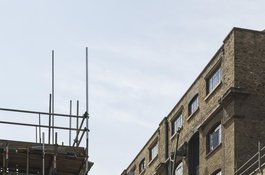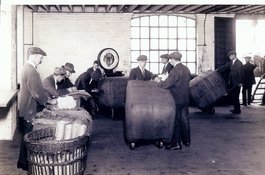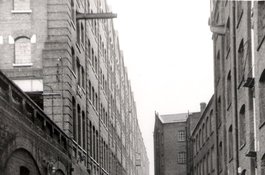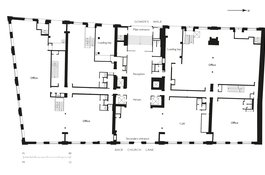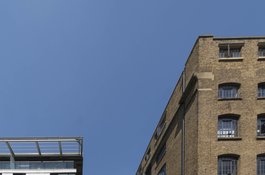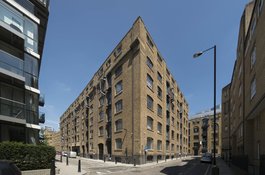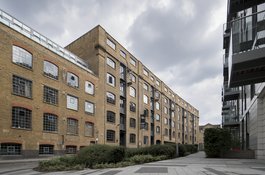The Loom, 101 Back Church Lane
Contributed by Survey of London on June 5, 2020
The Loom is a converted wool warehouse of 1889–90, bounded south and west by
the then newly made Hooper Street and a straightened and widened section of
Gower’s Walk, outcomes of the construction of the Commercial Road Goods Depot.
The site had been the southern part of a late eighteenth-century parochial
burial ground, built up after 1800, Harris’s Yard with a mission hall, and a
long-lived animal-charcoal works. The warehouse was built for Browne &
Eagle, wool merchants, a firm founded around 1840 by George Elliot Browne
(1807–1853), who was joined in partnership about 1846 by George Christopher
Eagle (1826–1873), from Mile End. After Browne’s death, Eagle married his
widow and built up the business from a base in the City, importing wool from
Australia, and from 1864 taking and building warehouses in Whitechapel. The
firm continued to expand after Eagle’s demise, locally and otherwise, up to
and beyond the building of these premises on Back Church Lane, Whitechapel’s
only surviving wool warehouse.
Holland and Hannen, generally employed by Browne & Eagle, were the
builders of what was originally a five-storey building in five fireproof
divisions or ‘risks’, each with its own central loophole bay on both east and
west sides. In 1897, Browne & Eagle Ltd built an even larger warehouse on
the east side of Back Church Lane, for which Edwin A. B. Crockett (1835–1915),
then Surveyor to the Fire Offices Committee, was the architect. He claimed to
be following principles adopted in the earlier building, for which he was
perhaps also the architect. The two warehouses were connected from the south
end of earlier building’s east side by a tunnel and three iron footbridges,
removed in the 1960s. The London Hydraulic Power Company’s high-pressure mains
powered the wall cranes until 1903 when electricity took over.
Browne & Eagle Ltd had vacated the west-side warehouse by 1952. It was a
headquarters for Augustus Barnett, wine merchants, from about 1970 till the
late 1980s, after which the building, by then known as Old Loom House, was
used as office space by, inter alia, gift retailers and creative enterprises
including David Raphael Management, Stuart Batley Photography, the Independent
Theatre Council, and Paris Records. The building was acquired around 1987 by
the Berkley Group, established by Graham and Brian Meehan in 1977 to convert
neglected buildings and then expanding into grander projects. The warehouse
was formally converted in 1988–9 with a full storey and an attic added and a
central light well inserted for fifty-six office units. A canopied entrance on
Back Church Lane declared the building to be New Loom House. Occupants
included financial services and technology companies and health charities. The
building was acquired by the Yianis Group with a view to conversion to flats
but was sold on for £35m in 2013 to Helical, another developer, which elected
to refurbish the building as offices, work seen through in 2016–17. Some
tenants remained, including an original occupant, the Lloyd’s brokers Corrie
Bauckman Batts, but the design-conscious renovation by Duggan Morris,
architects, reflected a shift back towards the creative industries, if not to
the bohemian character of the 1980s, with fewer units and higher rents.
Widened entrances, with distinctive 12m sliding panels in strips of woven
steel, like ‘the reed-frame of an historic loom’, were formed on both main
elevations and linked by the Walk, a passage with bespoke mild-steel panel
lining and a polished concrete floor. A further sheep-themed artwork adorns
one wall of the enlarged light well which has landings railed with similar
woven-strip steel balusters. The Back Church Lane reception area opens into a
large café, initially a branch of the cyclist-friendly Look Mum No Hands!
replaced by Hermanos in 2019.
